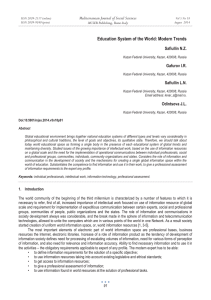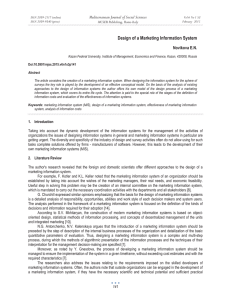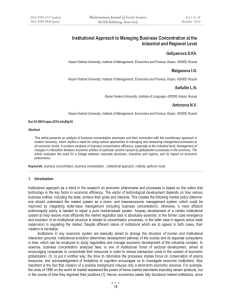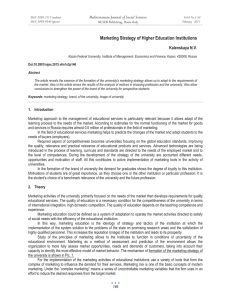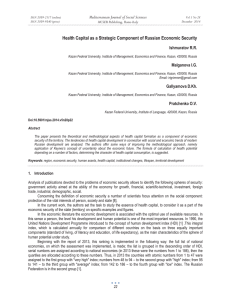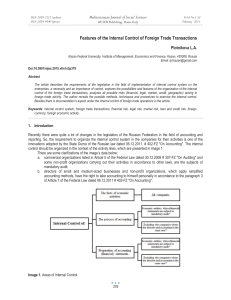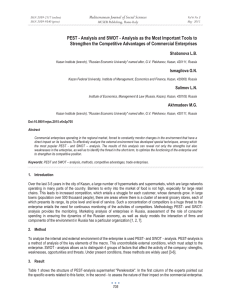ABC - Analysis, as an Important Tool for Generating an
advertisement
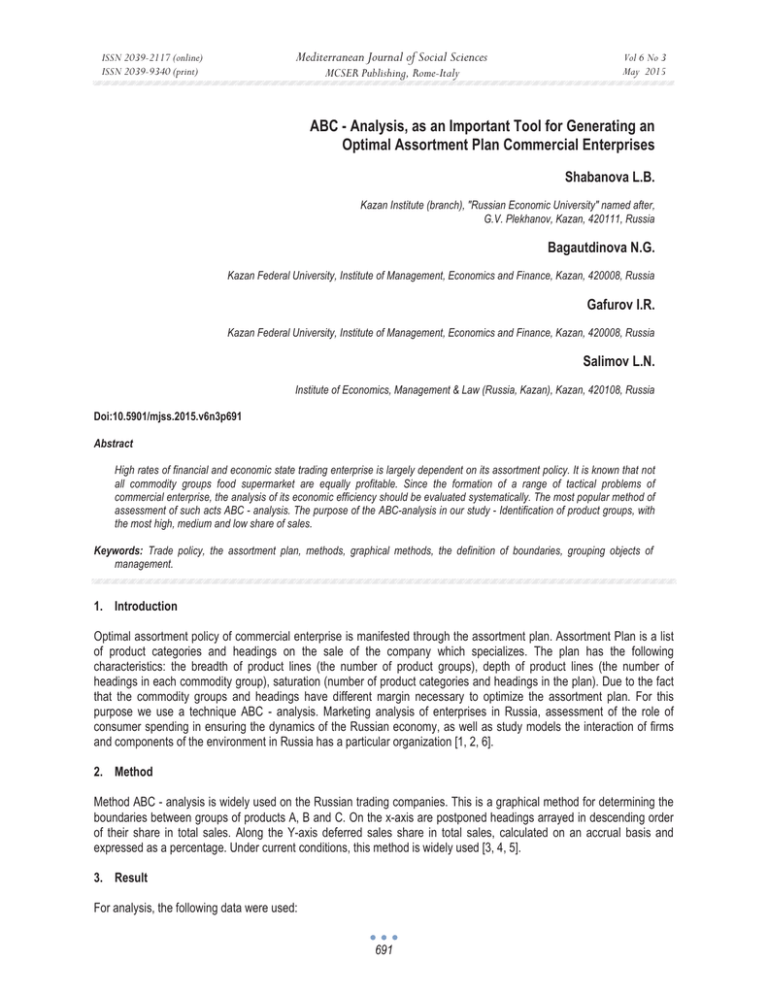
Mediterranean Journal of Social Sciences ISSN 2039-2117 (online) ISSN 2039-9340 (print) MCSER Publishing, Rome-Italy Vol 6 No 3 May 2015 ABC - Analysis, as an Important Tool for Generating an Optimal Assortment Plan Commercial Enterprises Shabanova L.B. Kazan Institute (branch), "Russian Economic University" named after, G.V. Plekhanov, Kazan, 420111, Russia Bagautdinova N.G. Kazan Federal University, Institute of Management, Economics and Finance, Kazan, 420008, Russia Gafurov I.R. Kazan Federal University, Institute of Management, Economics and Finance, Kazan, 420008, Russia Salimov L.N. Institute of Economics, Management & Law (Russia, Kazan), Kazan, 420108, Russia Doi:10.5901/mjss.2015.v6n3p691 Abstract High rates of financial and economic state trading enterprise is largely dependent on its assortment policy. It is known that not all commodity groups food supermarket are equally profitable. Since the formation of a range of tactical problems of commercial enterprise, the analysis of its economic efficiency should be evaluated systematically. The most popular method of assessment of such acts ABC - analysis. The purpose of the ABC-analysis in our study - Identification of product groups, with the most high, medium and low share of sales. Keywords: Trade policy, the assortment plan, methods, graphical methods, the definition of boundaries, grouping objects of management. 1. Introduction Optimal assortment policy of commercial enterprise is manifested through the assortment plan. Assortment Plan is a list of product categories and headings on the sale of the company which specializes. The plan has the following characteristics: the breadth of product lines (the number of product groups), depth of product lines (the number of headings in each commodity group), saturation (number of product categories and headings in the plan). Due to the fact that the commodity groups and headings have different margin necessary to optimize the assortment plan. For this purpose we use a technique ABC - analysis. Marketing analysis of enterprises in Russia, assessment of the role of consumer spending in ensuring the dynamics of the Russian economy, as well as study models the interaction of firms and components of the environment in Russia has a particular organization [1, 2, 6]. 2. Method Method ABC - analysis is widely used on the Russian trading companies. This is a graphical method for determining the boundaries between groups of products A, B and C. On the x-axis are postponed headings arrayed in descending order of their share in total sales. Along the Y-axis deferred sales share in total sales, calculated on an accrual basis and expressed as a percentage. Under current conditions, this method is widely used [3, 4, 5]. 3. Result For analysis, the following data were used: 691 ISSN 2039-2117 (online) ISSN 2039-9340 (print) Mediterranean Journal of Social Sciences Vol 6 No 3 May 2015 MCSER Publishing, Rome-Italy • • • supermarket sales for the quarter of the year; the range presented in the form of commodity groups; revenue for each product - is calculated by multiplying the price of the goods on his sales for the quarter. revenue = sales _ volume * price (1.) • he share of each commodity group in the total range - calculated by the ratio of revenue to the commodity group's total revenue of all product groups.. share_ of _ revenue_ by _ product= revenue_ by _ product *100% total_ revenue (2.) Following the results of calculations of the best selling and highest revenue-bearing products, will be located in the blocks "A" and "B". Thus, the entire range of supermarket for the reporting quarter of the year was divided into product groups, the total amount of 41. Using the formula mentioned earlier, we have obtained the original data (see. Table 1) needed for the ABC analysis. Table 1. Initial data for ABC-analysis Sl. No Assortment position 1. 2. 3. 4. 5. 6. 7. 8. 9. 10. 11. 12. 13. 14. 15. 16. 17. 18. 19. 20. 21. 22. 23. 24. 25. 26. 27. 28. 29. 30. 31. 32. 33. 34. 35. 36. 37. 38. 39. 40. 41. In total Wine beverages Meat & sausage products Semi-finished products The low-alcohol products Cheese Vegetable oils Baking products Milk production Baby Food Confectionery Pasta Means for washing & cleaning Personal hygiene items Groats Juices Frozen products Non-alcoholic beverages Fishery products Canned Fish Tobacco Meat Canned Chips & Snacks Own pastries Flour Tea Coffee Vegetables & fruits Olive oil Stationery Salt Matches Utensils Eggs Sugar Perfume Salads Kitchenware Toys Sauces & spices Margarine products Goods for animals Revenue, thous. roubles 73692 54440 16213 15642 14436 11472 10070 9634 9211 8246 6800 4902 4367 3841 3786 3786 3280 3163 3163 2500 2324 2324 1757 1500 1411 1333 1088 951 951 614 512 512 512 495 241 186 145 110 111 111 14 279.846 Specific weight sales volume, % 26,30 19,45 5,76 5,50 5,15 4,09 3,59 3,44 3,29 2,94 2,42 1,75 1,56 1,37 1,35 1,35 1,17 1,13 1,13 0,89 0,83 0,83 0,62 0,54 0,50 0,47 0,38 0,34 0,34 0,22 0,18 0,18 0,18 0,17 0,08 0,06 0,05 0,04 0,03 0,03 0,005 99,665 692 Share in the turnover on an accrual basis, % 26,3 45,75 51,51 57,01 62,16 66,22 69,81 73,25 76,54 79,48 81,9 83,65 85,21 86,58 87,93 89,28 90,45 91,58 92,71 93,6 94,43 95,26 95,88 96,42 96,92 97,39 97,77 98,11 98,45 98,67 98,85 99,03 99,2 99,37 99,45 99,51 99,56 99,6 99,63 99,66 99,665 99,665 Classification Ⱥ ȼ ɋ ISSN 2039-2117 (online) ISSN 2039-9340 (print) Mediterranean Journal of Social Sciences MCSER Publishing, Rome-Italy Vol 6 No 3 May 2015 Using the data in Table 1 we construct a curve Lorentz concentration, where the x-axis are arranged product groups, in descending order of their share in total sales, and the vertical axis - the size of turnover. Border blocks "A", "B" and "C" was determined by the tangent to the curve analysis (see. Figure. 1). Figure. 1. ABC analysis supermarket "Perekrestok" in the reporting quarter of the year 4. Conclusion The obtained results allow us to conclude that the most advantageous from an economic point of view for the supermarket "Perekrestok" is the sale of the first 11 product groups on the list in Table 1. - These goods included in the block "A". The block "B" are 9 product groups. Do not forget that they are also beneficial to the commercial enterprise, but the return they gain less than the profits from the sale of goods Block "A". In the block "C" includes all remaining items in Table 1. Note that they account for almost 50% of the total range of the supermarket. These products are not economically viable to implement. However, to give them a supermarket can not, as many of them are necessary for the buyers who come just for this group of products. All hopes seller focused on the fact that purchase goods from the commodity group "C", the buyer will make a number of acquisitions of goods from the block "A" or "B». References Bagautdinova N.G., Safiullin L.N., Minnahmetov R.R. Institutionalization of Firm Environment in Conditions of Growing Turbulence // Mediterranean Journal of Social Sciences, 2014. Volume 5, No 12, pp. 55-58. Handanhal Ravinder, Ram B. Misra. ABC Analysis For Inventory Management: Bridging The Gap Between Research and Classroom // American Journal Of Business Education – Third Quarter 2014 Volume 7, No 3. pp. 257-263. M. Karthick, S. Karthikeyan, M.C. Pravin. A Model for Managing and Controlling the Inventory of Stores Items based on ABC Analysis // Global Journal of Researches in Engineering: Industrial Engineering. Volume 14, Issue 2, Version 1.0, 2014. pp. 1-6. Bagautdinova N.G., Safiullin L.N., Badrtdinov N.N. The Role of Consumer Expenses in Ensuring Forward Dynamics of The Russian Economy // Mediterranean Journal of Social Sciences, 2014. Volume 5, No 12, pp. 43-48. Mohammad Reza Motadel, Abbas Toloie Eshlagy, Sarvenaz Ghasemi. The Presentation of a Mathematical Model to Assess and Control the Inventory Control System through ABC Analysis Approach (A Case Study of Lino Meat Products Company) // International Journal of Information, Security and Systems Management, 2012, Vol. 1, No. 1, pp. 1-13. Safiullin M.R., Samigullin I.G., Safiullin L.N. Model of Management of Competitiveness of a Machine-building Complex // World Applied 693 ISSN 2039-2117 (online) ISSN 2039-9340 (print) Mediterranean Journal of Social Sciences MCSER Publishing, Rome-Italy Vol 6 No 3 May 2015 Sciences Journal 27 (Economics, Management and Finance), 2013, pp. 212-216. Shigabieva A.M., Safiullin L.N., Mazitov V.M., Saipullaev U.A. Some methodological foundation of an innovation theory. Life Science Journal 2014; 11(6s): 388 – 391. Ablaev I.M., Khovanskaya E.S. Essence and Economical Substance of Innovative Cluster in Territorially Localized Business System// Mediterranean Journal of Social Sciences.- Vol.5, No12, (2014)-pp.159 – 162. Ismagilova G.N., Safiullin L.N., Novenkova A.Z., Safiullin N.Z. Prospects of small business in Tatarstan. Life Science Journal 2014; 11(6s): 396 – 399. Ulesov D.N., Shigabieva A.M., Safiullin L.N., Shaidullin R.N. Essential features of small and medium business. Life Science Journal 2014; 11(6s): 392 – 395. 694
